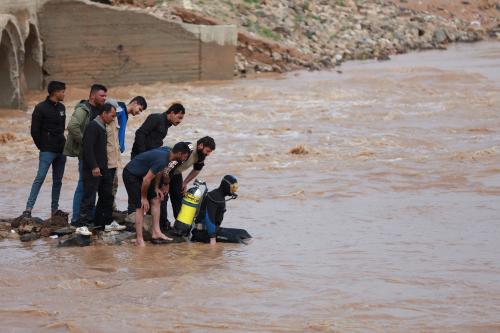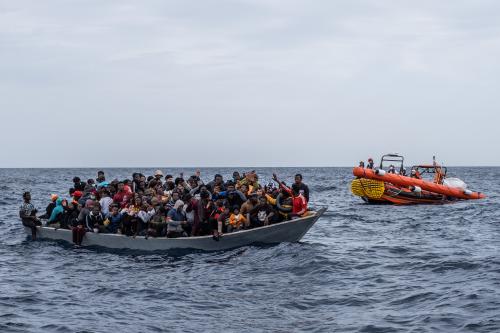Editor’s Note: The following paper was prepared for the Gilbert + Tobin Centre of Public Law’s “Conference on Climate Change and Migration in the Asia-Pacific: Legal and Policy Response” at the University of New South Wales in Sydney, Australia on November 10-11, 2011.
View video of Beth Ferris’s presentation at tv.unsw.edu.au »
As the theme of this conference makes clear, climate change is likely to lead to increased human mobility which will take different forms. The Conference of Parties to the United Nations Framework Convention on Climate Change (UNFCCC), meeting in Cancun (COP 16) in December 2010, recognized the potential impact of climate change on the movement of people when it invited all parties to the Convention:
“to enhance action on adaptation under the Cancun Adaptation Framework … by undertaking inter alia, the following: …(f) Measures to enhance understanding, coordination and cooperation with regard to climate change induced displacement, migration and planned relocation, where appropriate, at national, regional and international levels.”[1]
In my presentation today, I’d like to focus on the third category of ‘planned relocations.’ In the literature on climate change-induced displacement, there are several different categories of potential movement induced by climate change which fall into this category. For example:
-
people who need to be relocated from areas prone to sudden-onset natural disasters which are increasing in severity and intensity as a result of climate change (e.g. flood areas)[2]
-
people who need to be relocated because their country or parts of their country face destruction from the effects of climate change (e.g. small island states facing sea level rise)
-
people who are displaced because their livelihoods are threatened by slow-onset effects of climate change (e.g. drought, salinisation of water resulting from sea level rise) and who need to find new permanent homes
-
people who need to be relocated because of either mitigation projects (e.g. production of agrofuels and hydropower plants) or large-scale adaptation projects such as sea walls, replanting of mangroves, and restoration of marshlands
Walter Kälin, former Representative of the Secretary-General on the Human Rights of Internally Displaced Persons, posits that:
“Disasters will increase the need for governments to designate areas as high-risk zones too dangerous for human habitation. This means that people may have to be (forcibly) evacuated and displaced from their homes and prohibited from returning there and relocated to safe areas. This could occur, for example, because of increased risk of flooding or mudslides due to the thaw of the permafrost in mountain regions, but also along rivers and coastal plains prone to flooding. The difference between this situation and the previous typology of disaster-induced displacement is that return may not be possible, thus becoming a permanent form of displacement until other durable solutions are found for those affected.[3]
When areas become uninhabitable because of the effects of climate change, it is likely that most of those who move will be individuals or families who decide that conditions are such that it is time to leave their homes and communities. Some will move to join families and friends; they will send children to school in other regions; they will follow established paths of both internal and international migration. Individuals and families will make decisions on the basis of the perceived risk of staying where they are, analysis of possibilities for settlement elsewhere, and available resources for making the move. They will not expect government assistance in selling their homes and property, providing housing, or supporting their integration into a new community. For those who migrate spontaneously, no one will monitor how they are doing in their new environment. For those who are displaced in larger numbers, whether internally or across borders, governments and international agencies may seek to provide assistance to them and to keep track of their numbers and needs.
When people move on their own, they are considered to be migrants. When they are forced to move, they are displaced. While the degree of voluntariness of the decision varies significantly, for both migrants and the displaced, the locus of control is with them. When people are moved as a community as a planned relocation, the locus of control is with others, usually the government It should be noted that there are also a small number of cases such as two considered here – the Carteret islands in Papua New Guinea and Newtok, Alaska – where communities decide as a group that they need to move in order to survive. This presentation looks at cases where for one reason or another, people are relocated in a planned and systematic way.
[1] UNFCCC, Outcome of the work of the Ad Hoc Working Group on long-term Cooperative Action under the Convention, CP 16, 2010, http://unfccc.int/files/meetings/cop_16/application/pdf/cop16_lca.pdf#page=3, para 14(f)
[2] Note that such relocations may also be necessary for natural disasters which are not related to climate change, e.g. from the slopes of volcanoes or earthquake-prone areas.
[3] Walter Kälin, Displacement Caused by the Effects of Climate Change: Who Will Be Affected and What Are the Gaps in the Normative Framework for Their Protection?, paper presented to the IASC, 10 October 2008, https://www.brookings.edu/papers/2008/1016_climate_change_kalin.aspx


